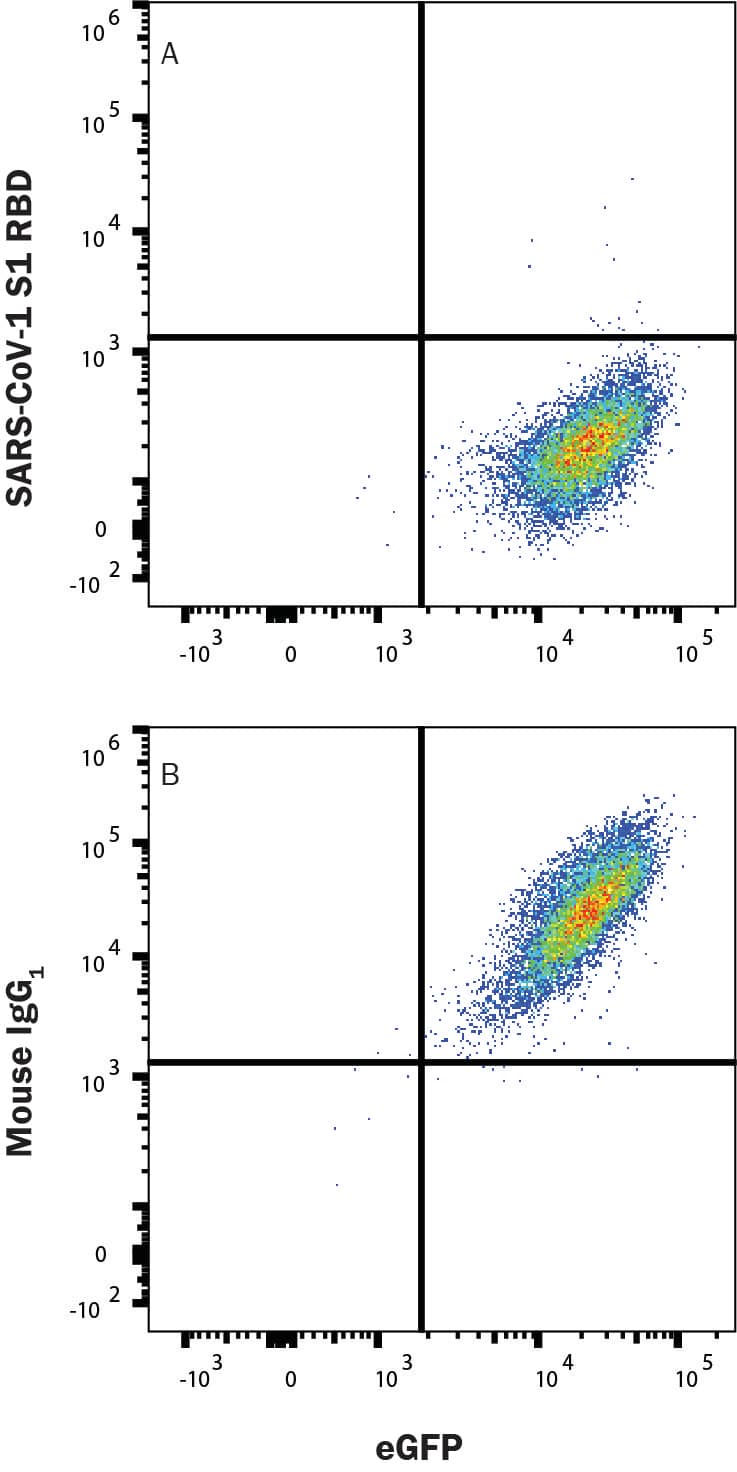SARS-CoV-2 Spike RBD Antibody Summary
Arg306-Phe527
Accession # NP_0828851.1
Applications
Please Note: Optimal dilutions should be determined by each laboratory for each application. General Protocols are available in the Technical Information section on our website.
Scientific Data
 View Larger
View Larger
SARS-Cov-2 Spike RBD protein binding to ACE-2-transfected Human Cell Line is Blocked by SARS-Cov-2 Spike RBD Antibody In a functional flow cytometry test, Recombinant SARS-Cov-2 Spike RBD His-tagged protein (10500-CV) binds to HEK293 human embryonic kidney cell line transfected with recombinant human ACE-2 and eGFP. (A) Binding is blocked by 50 µg/mL of Mouse Anti-SARS-Cov-2 Spike RBD Monoclonal Antibody (Catalog # MAB108271) but not by (B) Mouse IgG1 Isotype Control (MAB002). Protein binding was detected with Mouse Anti-His APC-conjugated Monoclonal Antibody (IC050A). Staining was performed using our Staining Membrane-Associated Proteins protocol.
 View Larger
View Larger
Detection of Spike RBD in CHO Chinese hamster ovary cell line transfected with SARS-CoV-2. Spike RBD was detected in immersion fixed CHO Chinese hamster ovary cell line transfected with SARS-CoV-2 (positive staining) and CHO Chinese hamster ovary cell line (non-transfected, negative staining) using Mouse Anti-SARS-CoV-2 Spike RBD Monoclonal Antibody (Catalog # MAB108271) at 8 µg/mL for 3 hours at room temperature. Cells were stained using the NorthernLights™ 557-conjugated Anti-Mouse IgG Secondary Antibody (red; Catalog # NL007) and counterstained with DAPI (blue). Specific staining was localized to cytoplasm. View our protocol for Fluorescent ICC Staining of Cells on Coverslips.
Reconstitution Calculator
Preparation and Storage
- 12 months from date of receipt, -20 to -70 °C as supplied.
- 1 month, 2 to 8 °C under sterile conditions after reconstitution.
- 6 months, -20 to -70 °C under sterile conditions after reconstitution.
Background: Spike RBD
SARS-CoV was discovered in association with cases of severe acute respiratory syndrome (SARS) that infected more than 8,000 persons with over 900 fatalities worldwide in 2002-2003 (1). It belongs to a family of viruses known as coronaviruses that also include MERS and SARS-Cov2 that causes the global pandemic coronavirus disease 2019 (Covid-19). Coronavirus is commonly comprised of four structural proteins: Spike protein(S), Envelope protein (E), Membrane protein (M), and Nucleocapsid protein (N) (1). SARS-CoV S Protein is a type-I trimerized membrane glycoprotein that mediates membrane fusion and viral entry. As with most coronaviruses, proteolytic cleavage of the S protein into two distinct peptides, S1 and S2 subunits, is required for activation. The S1 subunit is focused on attachment of the protein to the host receptor while the S2 subunit is involved with cell fusion (2-4). A metallopeptidase, angiotensin-converting enzyme 2 (ACE-2), has been identified as a functional receptor for SARS-CoV through interaction with a receptor binding domain (RBD) located at the C-terminus of S1 subunit (5, 6). Based on amino acid (aa) sequence homology, the RBD domain of SARS-Cov shares 73% and 24% homology with RBD domain of SARS-CoV2 and MERS, respectively. Before binding to the ACE-2 receptor, structural analysis of the S1 trimer shows that only one of the three RBD domains in the trimeric structure is in the "up" conformation. This is an unstable and transient state that passes between trimeric subunits but is nevertheless an exposed state to be targeted for neutralizing antibody therapy (7). Antibodies to S protein especially the RBD region of SARS-CoV have been shown to inhibit interaction with the ACE-2 receptor, confirming RBD as an attractive target for vaccinations or antiviral therapy (8).
- Rota, P.A. et al. (2003) Science 300:1394.
- Bosch, B.J. et al. (2003). J. Virol. 77:8801.
- Belouzard, S. et al. (2009) Proc. Natl. Acad. Sci. USA 106:5871.
- Millet, J.K. and G. R. Whittaker (2015) Virus Res. 202:120.
- Li, W. et al. (2003) Nature 426:450.
- Wong, S.K. et al. (2004) J. Biol. Chem. 279:3197.
- Ortega, J.T. et al. (2020) EXCLI J. 19:410.
- Du, L. el al. (2009) Nat. Rev. Microbiol. 7:226.
Product Datasheets
FAQs
No product specific FAQs exist for this product, however you may
View all Antibody FAQsReviews for SARS-CoV-2 Spike RBD Antibody
There are currently no reviews for this product. Be the first to review SARS-CoV-2 Spike RBD Antibody and earn rewards!
Have you used SARS-CoV-2 Spike RBD Antibody?
Submit a review and receive an Amazon gift card.
$25/€18/£15/$25CAN/¥75 Yuan/¥2500 Yen for a review with an image
$10/€7/£6/$10 CAD/¥70 Yuan/¥1110 Yen for a review without an image
